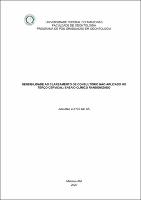| ???jsp.display-item.social.title??? |


|
Please use this identifier to cite or link to this item:
https://tede.ufam.edu.br/handle/tede/7728| ???metadata.dc.type???: | Dissertação |
| Title: | Sensibilidade ao clareamento de consultório não aplicado no terço cervical: ensaio clínico randomizado |
| Other Titles: | Sensitivity to in-office bleaching not applied in cervical area: randomized clinical trial |
| ???metadata.dc.creator???: | Sá, Juliana Lopes de  |
| ???metadata.dc.contributor.advisor1???: | Martins, Leandro de Moura |
| First advisor-co: | Martins, Luciana Mendonça da Silva |
| ???metadata.dc.contributor.referee1???: | Giorgi, Maria Cecília Caldas |
| ???metadata.dc.contributor.referee2???: | Pimentel, Adriana Corrêa de Queiroz |
| ???metadata.dc.description.resumo???: | Apesar de sua comprovada efetividade, o clareamento dentário pode levar à duvida quanto a presença de sensibilidade dentária. Por isso, tem-se buscado alternativas que possam reduzir a principal limitação do cirurgião-dentista. O objetivo deste trabalho foi comparar o risco absoluto e a intensidade da sensibilidade do clareamento com peróxido de hidrogênio a 35%, seguindo um protocolo de não aplicação do gel no terço cervical. Trinta e cinco pacientes foram selecionados para este ensaio clínico randomizado, paralelo, duplo cego e do tipo boca-dividida. Randomicamente, o grupo Barreira no Sulco (BS) recebeu a barreira gengival de resina fotopolimerizável até o nível do sulco gengival, e o grupo Barreira Cervical (BC) a barreira foi estendida por cerca de 2mm até que incluísse toda a região do terço cervical dos dentes. O peróxido de hidrogênio a 35% foi aplicado três vezes por 15 minutos, resultando em 45 minutos de cada sessão de clareamento. Foram realizadas 2 sessões com intervalo de 1 semana. A sensibilidade foi avaliada em 1 hora após cada sessão, entre 24 e 48 horas após e no retorno de 30 dias, por meio da Escala Numérica (NRS) e da Escala Visual Analógica (VAS). A avaliação da cor foi realizada antes do estudo, em um período de 1 semana após a primeira sessão, 2 semanas após a primeira sessão e 30 dias após a segunda sessão, com a escala Vita Clássica, escala Vita Bleach e espectrofotômetro Easyshade. A mudança de cor do clareamento e a intensidade da sensibilidade dentária foram avaliadas pelo teste de Wilcoxon pareado. O risco absoluto de sensibilidade dentária foi comparado pelo teste Mc Nemar (α = 0.05). A eficácia do clareamento foi observada nos dois grupos após 3 semanas do tratamento, sem diferença estatística. Não foi detectada diferença nos termos de risco à sensibilidade e intensidade da sensibilidade entre os grupos. Aproximadamente, 86% dos participantes experimentaram sensibilidade dentária, que foi registrada principalmente como “leve”. A não aplicação do gel com peróxido de hidrogênio a 35% no terço cervical parece não afetar o grau de clareamento e a sensibilidade dentária. |
| Abstract: | Despite its proven effectiveness, the bleaching can lead to doubt regarding the presence of tooth sensitivity. Therefore, alternatives have been sought to reduce the main limitation of the dentist. The study aimed to compare the absolute risk and intensity of the sensitivity of bleaching with hydrogen peroxide to 35%, following a protocol of non-application of the gel in the cervical area. Thirty-five patients were select for this parallel, double-blind study, split-mouth randomized trial. Randomly, the Barrier Sulcus (BS) group received the light-curable resin gingival barrier to the level of the gingival sulcus, and the Cervical Barrier (CB) group the barrier was extended by about 2mm to include the entire cervical area of the teeth. The 35% hydrogen peroxide was applied three times for 15 minutes, resulting in 45 minutes of each bleaching session. There were 2 sessions with a 1-week interval. Tooth sensitivity was recorded up to 1 hour after each session, between 24 and 48 hours after and 30 days after the second session, using the Numerical Scale (NRS) and Visual Analog Scale (VAS). The color changes was evaluated before the study, in a period of 1 week, 2 weeks and 30 days after the end of the bleaching treatment, with the Vita Clássica scale, Vita Bleach scale and Easyshade spectrophotometer. Color changes of bleaching and intensity of sensitivity of tooth was evaluated by the Wilcoxon-paired test. The absolute risk of tooth sensitivity was compared by the Mc Nemar’s test (α = 0.05). Effective bleaching was observed for both groups after three weeks, without statistical difference. Not detected difference in terms of risk of tooth sensitivity and intensity of tooth sensitivity was detected between groups. Approximately, 86% of the participants experienced tooth sensitivity, which was recorded mainly as ‘‘mild.’’ The non-application of the gel with hydrogen peroxide to 35% does not seem to affect the degree of bleaching and tooth sensitivity. |
| Keywords: | Dentes - Clareamento Odontologia - Aspectos estéticos Sensibilidade dentária Peróxido de hidrogênio Resinas dentárias |
| ???metadata.dc.subject.cnpq???: | CIÊNCIAS DA SAÚDE: ODONTOLOGIA: MATERIAIS ODONTOLÓGICOS |
| ???metadata.dc.subject.user???: | Clareamento dental Peróxido de hidrogênio Sensibilidade da dentina |
| Language: | por |
| ???metadata.dc.publisher.country???: | Brasil |
| Publisher: | Universidade Federal do Amazonas |
| ???metadata.dc.publisher.initials???: | UFAM |
| ???metadata.dc.publisher.department???: | Faculdade de Odontologia |
| ???metadata.dc.publisher.program???: | Programa de Pós-graduação em Odontologia |
| Citation: | SÁ, Juliana Lopes de. Sensibilidade ao clareamento de consultório não aplicado no terço cervical: ensaio clínico randomizado. 2019. 50 f. Dissertação (Mestrado em Odontologia) - Universidade Federal do Amazonas, Manaus, 2019. |
| ???metadata.dc.rights???: | Acesso Aberto |
| URI: | https://tede.ufam.edu.br/handle/tede/7728 |
| Issue Date: | 9-Dec-2019 |
| Appears in Collections: | Mestrado em Odontologia |
Files in This Item:
| File | Description | Size | Format | |
|---|---|---|---|---|
| Dissertação_JulianaSá_PPGO.pdf | Dissertação_JulianaSá_PPGO | 1.93 MB | Adobe PDF |  Download/Open Preview |
Items in DSpace are protected by copyright, with all rights reserved, unless otherwise indicated.




